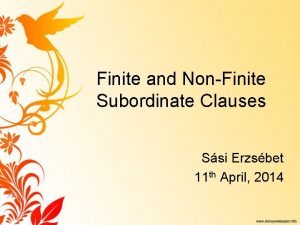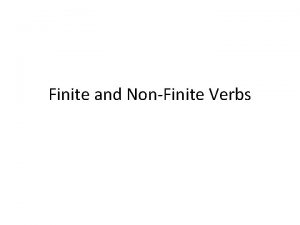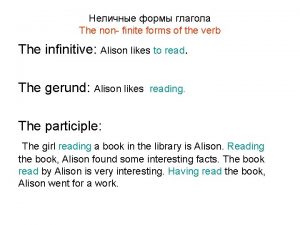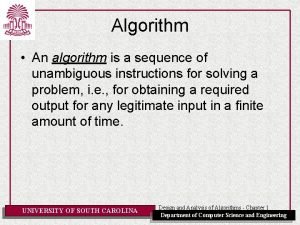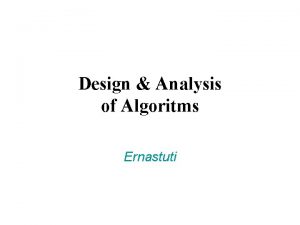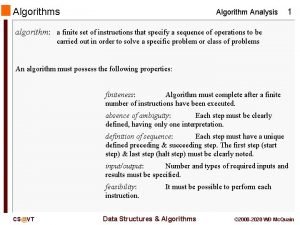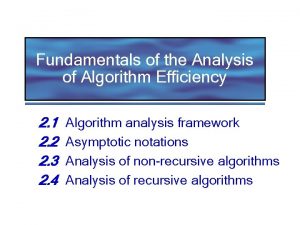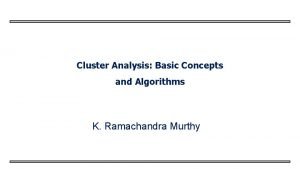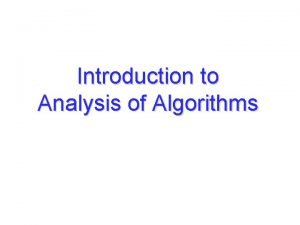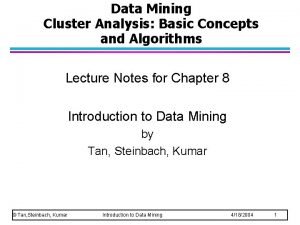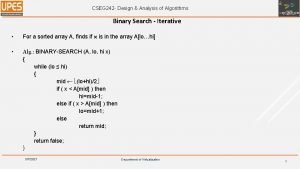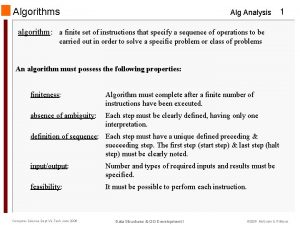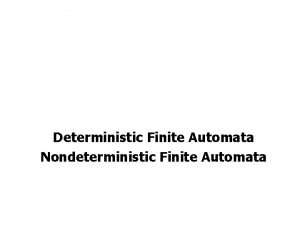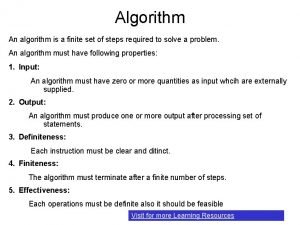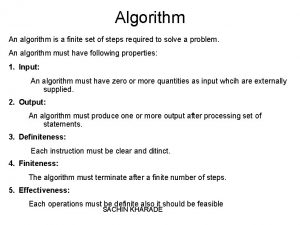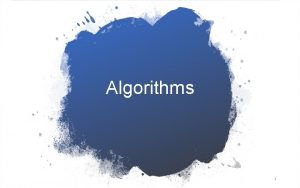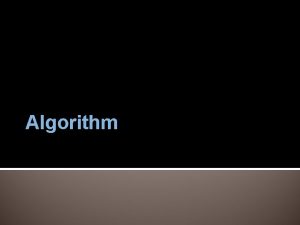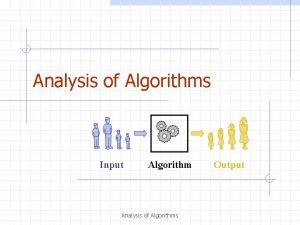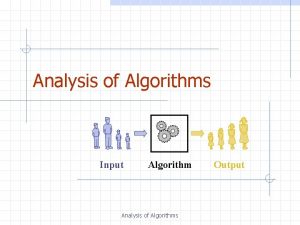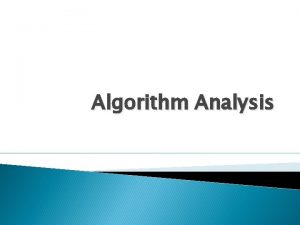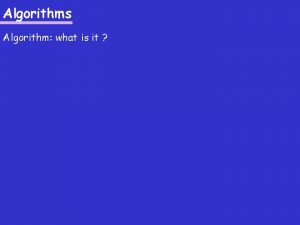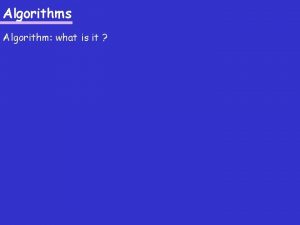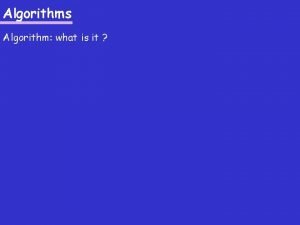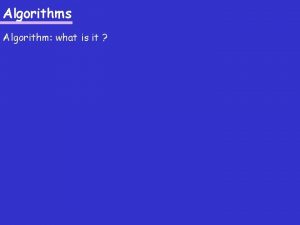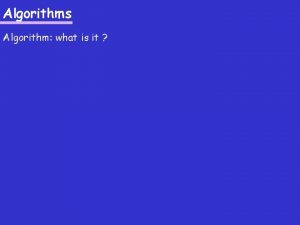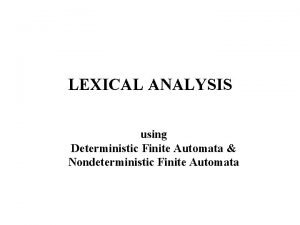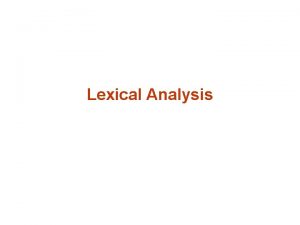Algorithms Algorithm Analysis 1 algorithm a finite set

























- Slides: 25

Algorithms Algorithm Analysis 1 algorithm: a finite set of instructions that specify a sequence of operations to be carried out in order to solve a specific problem or class of problems An algorithm must possess the following properties: finiteness: Algorithm must complete after a finite number of instructions have been executed. absence of ambiguity: Each step must be clearly defined, having only one interpretation. definition of sequence: Each step must have a unique defined preceding & succeeding step. The first step (start step) & last step (halt step) must be clearly noted. input/output: Number and types of required inputs and results must be specified. feasibility: instruction. CS@VT It must be possible to perform each Data Structures & Algorithms © 2000 -2020 WD Mc. Quain

Algorithms vs Programs program: Algorithm Analysis 2 a concrete expression of an algorithm in a particular programming language Given a problem to solve, the design phase produces an algorithm. The implementation phase then produces a program that expresses the designed algorithm 1 algorithm 2 . . . p r o b l e m . . . program 1. . program 2 . . algorithm k . . . program n . . CS@VT Data Structures & Algorithms © 2000 -2020 WD Mc. Quain

Design Considerations Algorithm Analysis 3 Given a particular problem, there are typically a number of different algorithms that will solve that problem. A designer must make a rational choice among those algorithms. Design considerations: - to design an algorithm that is easy to understand, implement, and debug (software engineering) - to design an algorithm that makes efficient use of the available computational resources (data structures and algorithm analysis) We will be primarily concerned with the second area. But, how do we measure the efficiency of an algorithm? Note that the number of operations to be performed and the space required will depend on the number of input values that must be processed. CS@VT Data Structures & Algorithms © 2000 -2020 WD Mc. Quain

Benchmarking Algorithm Analysis 4 It is tempting to measure the efficiency of an algorithm by producing an implementation and then performing benchmarking analyses by running the program on input data of varying sizes and measuring the "wall clock" time for execution. However: - the program may be a poor representation of the algorithm's possibilities. - the results will depend upon the particular characteristics of the hardware used for the benchmarking, perhaps in subtle ways. - the choice of test data may not provide a representative sampling of the various factors that influence the algorithm's behavior CS@VT Data Structures & Algorithms © 2000 -2020 WD Mc. Quain

Complexity Analysis Algorithm Analysis 5 Complexity analysis is the systematic study of the cost of a computation, measured either in time units or in operations performed, or in the amount of storage space required. The goal is to have a meaningful measure that permits comparison of algorithms and/or implementations independent of operating platform. Complexity analysis involves two distinct phases: - algorithm analysis: analysis of the algorithm or data structure to produce a function T(n) measuring the complexity - order of magnitude (asymptotic) analysis: analysis of the function T(n) to determine the general complexity category to which it belongs. CS@VT Data Structures & Algorithms © 2000 -2020 WD Mc. Quain

Algorithm Analysis 6 Algorithm analysis requires a set of rules to determine how operations are to be counted. There is no generally accepted set of rules for algorithm analysis. In some cases, an exact count of operations is desired; in other cases, a general approximation is sufficient. The rules presented that follow are typical of those intended to produce an exact count of operations. CS@VT Data Structures & Algorithms © 2000 -2020 WD Mc. Quain

Exact Analysis Rules 1. 2. 3. 4. Algorithm Analysis 7 We assume an arbitrary time unit. Execution of one of the following operations takes time 1: a) assignment operation b) single I/O operations c) single Boolean operations, numeric comparisons d) single arithmetic operations e) function return f) array index operations, pointer dereferences Running time of a selection statement (if, switch) is the time for the condition evaluation + the maximum of the running times for the individual clauses in the selection. Loop execution time is the sum, over the number of times the loop is executed, of the body time + time for the loop check and update operations, + time for the loop setup. Always assume that the loop executes the maximum number of iterations possible CS@VT Data Structures & Algorithms © 2000 -2020 WD Mc. Quain

Analysis Example 1 Algorithm Analysis Rule 2 a: time 1 before loop 8 Rule 2 b: time 1 before loop Sum = 0; In >> Value; while ( In ) { } if ( Value < 0 ) { Sum = -Sum; Sum = Sum + Value; } else { Sum = Sum + Value; } In >> Value; Rule 2 c: time 1 at beginning of each pass, and once more Rule 2 c: time 1 on each pass Rules 2 ad: time 2, if done Rules 2 ad: time 1 on each pass So, assuming n input values are received, the total time T(n) is given by: CS@VT Data Structures & Algorithms © 2000 -2020 WD Mc. Quain

Analysis Example 2 Given: Algorithm Analysis 9 for (i = 0; i < n-1; i++) { } for (j = 0; j <= i; j++) { aray[i][j] = 0; } Rules 4, 2 c and 2 d: time 3 on each iteration of outer loop, and one more test to exit Rules 4 and 2 a: time 1 before loop for (i = 0; i < n-1; i++) { Rules 4 and 2 a: time 1 on each iteration of outer loop Rules 4, 2 c and 2 d: time 2 (on each iteration of inner loop) and one more test to exit for (j = 0; j <= i; j++) { } } aray[i][j] = 0; Rule 2 a and 2 f: time 3 on each pass of inner loop So, the total time T(n) is given by: CS@VT Data Structures & Algorithms © 2000 -2020 WD Mc. Quain

Analysis Example 2 CS@VT Algorithm Analysis 10 Data Structures & Algorithms © 2000 -2020 WD Mc. Quain

Analysis Example 3 Algorithm Analysis 11 Rule 2 a: time 1 before loop Rules 4 and 2 a: time 1 before loop Rules 4, 2 c and 2 d: time 3 on each iteration of outer loop, plus one more test Sum = 0; for (k = 1; k <= n; k = 2*k) { Rules 4 and 2 a: time 1 on each iteration of outer loop } Rules 4, 2 c and 2 d: time 2 (on each iteration of inner loop) plus one more test for (j = 1; j <= n; j++) { } Sum++; Rule 2 a: time 1 on each pass of inner loop The tricky part is that the outer loop will be executed about log(n) times. How can we express this precisely? CS@VT Data Structures & Algorithms © 2000 -2020 WD Mc. Quain

Analysis Example 3 Algorithm Analysis 12 Precisely, n equals 2 log(n). So, we can argue that if p is the number of the current pass (numbering starting at 1) then: Here, x is the largest integer that’s less than or equal to x, commonly called the floor. CS@VT Data Structures & Algorithms © 2000 -2020 WD Mc. Quain

Analysis Example 3 Algorithm Analysis 13 So, the total time T(n) for the previous algorithm is given by: If we assume that n is a power of 2, the floor notation may be dropped. It is common to do so when expressing complexity functions, since the difference is minor. CS@VT Data Structures & Algorithms © 2000 -2020 WD Mc. Quain

Analysis Example 4 Algorithm Analysis 14 Now let’s consider a simple linear search function: int linear. Search(int List[], int Target, int Sz) { } for (int i = 0; i < Sz; i++) { if ( Target == List[i] ) return i; } // 1 before, 2 each pass, 1 exit // 2 // 1, if done return Sz; // 1, if done The worst-case cost would be incurred if Target does not occur in List. In that case: The best-case cost would be incurred if Target occurs at index 0 in List. In that case: CS@VT Data Structures & Algorithms © 2000 -2020 WD Mc. Quain

Analysis Example 4 Algorithm Analysis 15 What about the average cost? If Target occurs at index K in List, the cost of the search would be: The average-case cost, assuming Target is in List would be: CS@VT Data Structures & Algorithms © 2000 -2020 WD Mc. Quain

Analysis Example 4 Algorithm Analysis 16 The true average-case cost would depend on the probability that Target does occur in the list. Obviously, the cost of the search when Target is not in the list would be worst case cost found earlier. But the true average cost would depend on how many searches did achieve the worst case performance. As a side note, if we only count comparisons of data objects, the average-case cost, assuming Target is in List would be: CS@VT Data Structures & Algorithms © 2000 -2020 WD Mc. Quain

Analysis Example 5 Algorithm Analysis 17 Now let’s consider a simple binary search function: int bin. Search(int List[], int Target, int Sz) { unsigned int Mid, Lo = 0, Hi = Sz – 1; // 1 // 2 while ( Lo <= Hi ) { // 1 per pass + 1 for exit, if done Mid = (Lo + Hi) / 2; // 3 if ( List[Mid] == Target ) return Mid; // 2 // 1, if done else if ( Target < List[Mid] ) // 2, if done Hi = Mid – 1; // 2, if done } } else Lo = Mid + 1; return Sz; // 2, if done // 1, if done The worst-case cost of one pass through the loop is easily seen to be 10. . . CS@VT Data Structures & Algorithms © 2000 -2020 WD Mc. Quain

Analysis Example 5 Algorithm Analysis 18 … but how many passes will be required, in the worst case? Consider the loop condition in this form: Hi – Lo >= 0 Each pass through the loop (worst case) either raises Lo or lowers Hi. No matter which is done, simple algebra reveals that the successive loop tests are just: The denominator is 2 p where p is the number of the pass about to be performed (starting with p = 0). The constant term is bounded by 2. CS@VT Data Structures & Algorithms © 2000 -2020 WD Mc. Quain

Analysis Example 5 Algorithm Analysis 19 Now, from the initializations of Hi and Lo, the value of Hi – Lo is just Sz – 1. So, the question is essentially, when will we achieve: That’s messy, but it’s easy enough to show we need So, the number of operations for the binary search function is about: CS@VT Data Structures & Algorithms © 2000 -2020 WD Mc. Quain

Why Does Complexity Matter? Algorithm Analysis 20 Consider the following chart of some simple complexity function terms: CS@VT Data Structures & Algorithms © 2000 -2020 WD Mc. Quain

Running Time Estimation Algorithm Analysis 21 Suppose we have hardware capable of executing 106 instructions per second. How long would it take to execute an algorithm whose complexity function was: on an input of size N = 108? The total number of operations to be performed would be T(108): The total number of seconds required would be given by T(108)/106 so: The number of seconds/day is 86, 400 so this is about 115, 740 days (317 years). CS@VT Data Structures & Algorithms © 2000 -2020 WD Mc. Quain

Running Time Estimation Algorithm Analysis 22 What if we used an algorithm whose complexity function was: on an input of size N = 108? The total number of operations to be performed would be T(108): The total number of seconds required would be given by T(108)/106 so: This is about 44. 33 minutes. CS@VT Data Structures & Algorithms © 2000 -2020 WD Mc. Quain

Maximum Problem Size Algorithm Analysis 23 Another way of looking at this is to ask, what is the largest problem size that can be handled in a given amount of time, given a complexity function for an algorithm and the hardware speed? Assuming the same hardware speed as before, what's the largest input size that could be handled in one hour, if the complexity function is once again: The total number of seconds required would again be given by T(N)/106 so we're asking what is the maximum value of N for which: or This yields CS@VT Data Structures & Algorithms © 2000 -2020 WD Mc. Quain

Maximum Problem Size Algorithm Analysis 24 Applying the same logic, with the complexity function: The total number of seconds required would be T(N)/106 so we're asking what is the maximum value of N for which: Solving for equality (Newton's Method) yields about The first moral is that for large N, the complexity function matters. The minor first moral is that for large N, Nlog(N) is a LOT faster than N 2. The second moral involves applying this logic to the question of hardware speedup… CS@VT Data Structures & Algorithms © 2000 -2020 WD Mc. Quain

Faster Hardware? Algorithm Analysis 25 If we apply the same analysis, assuming that we can now find hardware that is, say, 100 times faster than the previous hardware (so 108 operations per second), the results are revealing: T(N) time for N = 108 max N in 1 hour N log(N) . 4433 minutes ~10 billion N 2 3. 17 years ~600, 000 Comparing to the earlier results, speeding up the hardware by a factor of 100: - reduces time for same sized problem by a factor of 100 in both cases, so the relative advantage of the N log(N) algorithm is retained - increases the max problem size by a factor of 10 for the N 2 case, versus a factor of almost 75 for the N log(N) case CS@VT Data Structures & Algorithms © 2000 -2020 WD Mc. Quain
 Non finite subordinate clause
Non finite subordinate clause Learning objectives for finite and non finite verbs
Learning objectives for finite and non finite verbs Learning objectives for finite and non finite verbs
Learning objectives for finite and non finite verbs Finite and non finite verb
Finite and non finite verb Finite and non finite
Finite and non finite Total set awareness set consideration set
Total set awareness set consideration set Training set validation set test set
Training set validation set test set Unambiguous algorithm
Unambiguous algorithm Finite set example
Finite set example Design and analysis of algorithms syllabus
Design and analysis of algorithms syllabus Algorithm analysis examples
Algorithm analysis examples What is analysis of algorithm
What is analysis of algorithm Association analysis: basic concepts and algorithms
Association analysis: basic concepts and algorithms Algorithm input output example
Algorithm input output example Analysis of algorithms
Analysis of algorithms Analysis of algorithms
Analysis of algorithms Fundamentals of analysis of algorithm efficiency
Fundamentals of analysis of algorithm efficiency Cluster analysis: basic concepts and algorithms
Cluster analysis: basic concepts and algorithms Randomized algorithms and probabilistic analysis
Randomized algorithms and probabilistic analysis Design and analysis of algorithms introduction
Design and analysis of algorithms introduction Analysis of algorithms lecture notes
Analysis of algorithms lecture notes Cluster analysis basic concepts and algorithms
Cluster analysis basic concepts and algorithms Cluster analysis basic concepts and algorithms
Cluster analysis basic concepts and algorithms Goals of analysis of algorithms
Goals of analysis of algorithms Cluster analysis basic concepts and algorithms
Cluster analysis basic concepts and algorithms Binary search in design and analysis of algorithms
Binary search in design and analysis of algorithms
